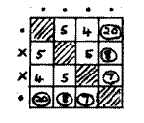General Report on Tunny
24X Page 147
When a rectangle has a positive decibanage on significance test IV it is usually said to be 'significant'.
(f) Significance tests for flags.
When a flag is entered double (in the form of a square) and is crudely converged, the convergence differs from ordinary crude convergence in that it is one-sided instead of two-sided. That is to say the 'pattern' which is taken through the flag gives rise to another pattern which is written down on the same side of the flag. It is not necessarily possible to reach a complete convergence - it may be necessary to doubt some characters in order to avoid an oscillation of the pattern. For example consider
 |
the flag shown in the diagram. The pattern inevitably oscillates between .... and .xx. or else between xxxx and x..x. Observe that a pattern is equivalent to itself inside out just as in the case of an ordinary rectangle. If the effect of oscillation is ignored we may say that there are 2n-1 different possible patterns to choose between, so the prior probability of any particular pattern is 2-n+1. The sum of the moduli of the pippages is till denoted by Χ, and the sigma-age of a convergence is X/(2σ) where σ2 = sum of square of entries in triangular flag. The presence of the factor 2 in the denominator is due to all the evidence being counted twice in virtue of the double-entering of the flag. The flag can be regarded as significant if the function
 is greater than 3(n-1) decibans (where Ψ is the function defined in chapter 21). (See R2 p 92, R3 p 8.) This test is the analogue of significance test II for rectangles. It can be improved by making a mental allowance for ν terms (as in significance test IV). Thus every very small pippage of a character is worth 3 decibans.
is greater than 3(n-1) decibans (where Ψ is the function defined in chapter 21). (See R2 p 92, R3 p 8.) This test is the analogue of significance test II for rectangles. It can be improved by making a mental allowance for ν terms (as in significance test IV). Thus every very small pippage of a character is worth 3 decibans.
This test assumes a flag to be a random collection of numbers and this assumption is not strictly true even if the rectangle from which it is derived is random.
It is rare that a 9 by 9 flag has a significant convergence except for a very significant rectangle (R3 p 82). The main application
Back to General Report on Tunny. Contents.